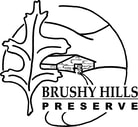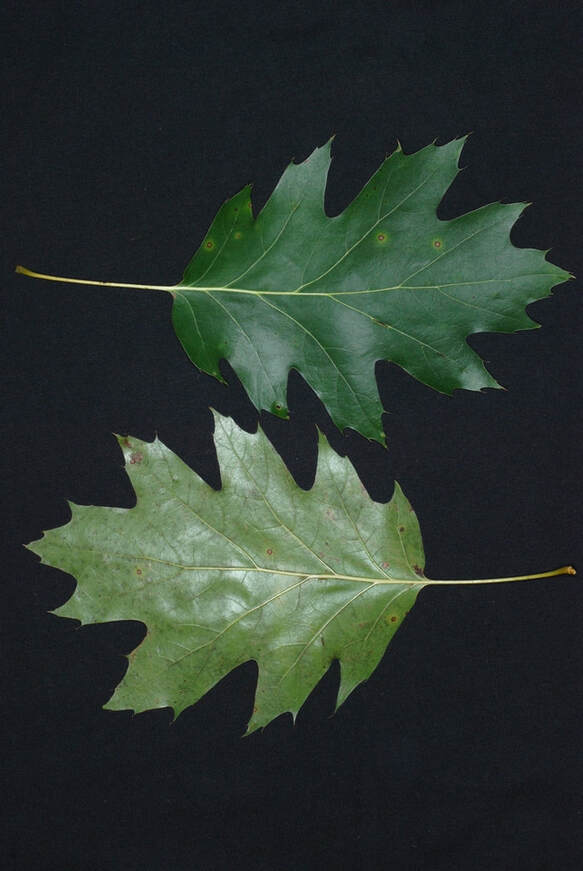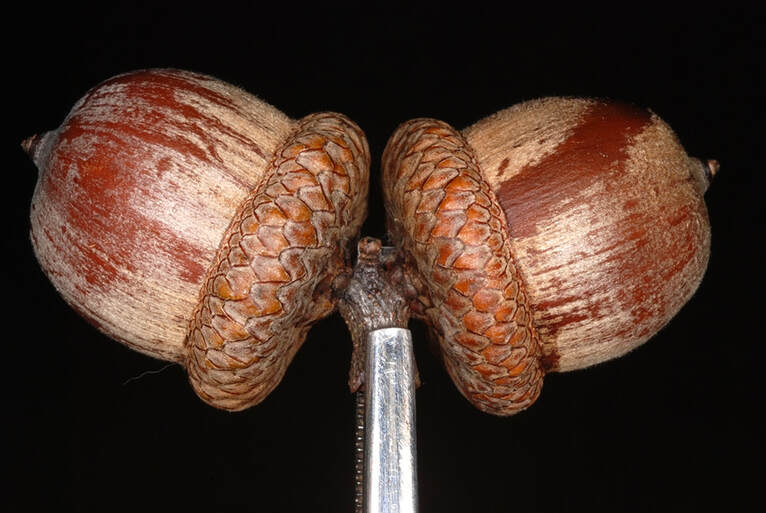Northern Red Oak
Scientific Name: Quercus rubra
— pronounced KWER-kus RU-bra
— Quercus, Latin for oak tree
— rubra, Latin for red
Beech Family (Fagaceae), which includes beeches and chestnuts
Other Common Names: Eastern Red Oak, Champion Oak
The Northern Red Oak’s bark is smooth on young trees; as it ages, wide, flat-topped ridges and shallow furrows develop. The flat ridges form a pattern resembling ski tracks.
The leaves are dull green on the upper sides. The undersides are paler and have no hairs in the vein axils. They have 7 to 11 bristle-tipped lobes, and the sinuses (spaces between the lobes) extend 1/3 to 1/2 way to the midvein.
— pronounced KWER-kus RU-bra
— Quercus, Latin for oak tree
— rubra, Latin for red
Beech Family (Fagaceae), which includes beeches and chestnuts
Other Common Names: Eastern Red Oak, Champion Oak
The Northern Red Oak’s bark is smooth on young trees; as it ages, wide, flat-topped ridges and shallow furrows develop. The flat ridges form a pattern resembling ski tracks.
The leaves are dull green on the upper sides. The undersides are paler and have no hairs in the vein axils. They have 7 to 11 bristle-tipped lobes, and the sinuses (spaces between the lobes) extend 1/3 to 1/2 way to the midvein.
Photos: Laves by Douglas Goldman USDA CC
Inconspicuous male and female flowers appear in the spring, and the fruits appear in the fall. The fall foliage is reddish-brown. The acorn is 3⁄4” to 11⁄2” long, with a flat, thick cap that covers about 1/4 of the nut. The cap has tightly overlapping scales.
Inconspicuous male and female flowers appear in the spring, and the fruits appear in the fall. The fall foliage is reddish-brown. The acorn is 3⁄4” to 11⁄2” long, with a flat, thick cap that covers about 1/4 of the nut. The cap has tightly overlapping scales.
More photos and ID help: VA Tech Dendrology
Northern Red Oak is found on a variety of sites but does best on rich, moist, well-drained soils. It can be found throughout the Preserve.
Interesting Facts:
Northern Red Oak is found on a variety of sites but does best on rich, moist, well-drained soils. It can be found throughout the Preserve.
Interesting Facts:
- Northern Red Oak acorns mature in two growing seasons, drop in the fall, and sprout in the following spring. (This is characteristic of the red oak group; for a description of red and white oak groups, click here.)
- As with most other deciduous oaks, leafout takes place in spring when day length has reached 13 hours: it is tied entirely to photoperiod and will take place regardless of air temperature. As a consequence, in cooler regions Northern Red Oaks often lose their flowers to late spring frosts, resulting in no seed crop for the year.
- Acorns from Northern Red Oaks are eaten by blue jays, wild turkeys, squirrels, small rodents, whitetail deer, raccoons, and black bears. In wintertime, deer browse the buds and twigs.


